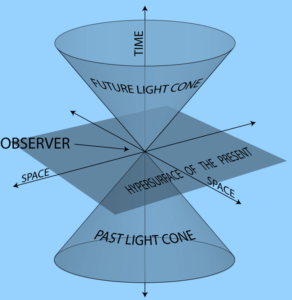Table of Contents
The theory of special relativity helps explain space and time, as well as the movement of objects in a straight line at a constant speed. When the speed of the object’s movement is compared to the speed of light, the mass of the same object becomes infinite, and it is thus forbidden to move faster than the speed of light. Albert Einstein developed the theory of special relativity in 1905, which further investigates the acceleration of such objects and serves as the foundation for Einstein’s Theory of General Relativity in 1915.
Albert Einstein’s Special Theory of Relativity’s 2 fundamental postulates are:
- Physics’ laws are consistent throughout.
- Light travels at the same speed in a vacuum as it does in any other space, regardless of its source.
This contradicts the popular belief that universal time is dependent on a reference frame and spatial position.
Einstein’s special theory of relativity preserves the principle of Galilean relativity. Such a theory states that the body (whether at rest or in uniform motion in a straight line) obeys the principle of inertia.
Special relativity is really only applicable to objects that can move in unison with one another and cannot be distinguished. Each and every object can approach but never surpass the speed of light. The renowned Einstein equation, E=mc2, was also created. This one was stated that mass and energy are frequently interchangeable and that the increased relativistic mass from its Kinetic Energy E can be divided by c2.

Space and Time Relativity
Einstein replaced the entire space and time with relative definitions to that of an observer in order to take the speed of light as constant. Consider two passengers in a train, one standing across a straight platform and the other sitting inside a train that is moving at a constant speed alongside the platform. The set (standing) passenger can easily mark a fixed point on the track and keep a close eye on the time, whereas the passenger inside the train can choose a spot on the platform and use his watch to measure the time. It thus forced Einstein to confront simultaneity, and the specific theory of relativity can be illustrated with the following example:
Standing in a field, an observer noticed lightning in two (fixed) trees 60 kilometres apart. When a moving passenger sitting inside a bus passed the observer, lightning struck. Every image travels the same distance for the observer, and he sees them all at the same time. Even so, one of the events is closer to the other for the moving observer. As a result, Einstein came to the conclusion that even simultaneity is relative. As a consequence, he drew inspiration for new time and space equations from the Lorentz transformation.

In which u and u’ are the relative speeds of the two moving objects as observed by the observer. As a result, the first postulate holds true in this case, where the speed of light is constant for all observers.
It prompted Einstein to combine time and space equations into two physical principles: conservation of energy and conservation of mass in a closed system. As an outcome, the second postulate of the special theory of relativity holds true in this equation as well.
The rest mass of a moving observer inside a spacecraft is referred to as mass m0, and the fixed observer’s mass is referred to as mass m, which can be expressed as:

FAQs
What does Einstein’s Special Theory of Relativity state?
Albert Einstein's theory of special relativity asserts that the laws of physics are the same for all uniformly moving observers because the speed of light in a vacuum remains constant regardless of the observer's speed. The special relativity theory elaborates on mass-energy equivalence, simultaneity relativity, length contraction, and a universal speed limit.
What is the difference between the general and special theory of relativity?
The key distinction between general and special relativity is that general relativity is concerned with gravity and acceleration, whereas special relativity is concerned with speed and time.





